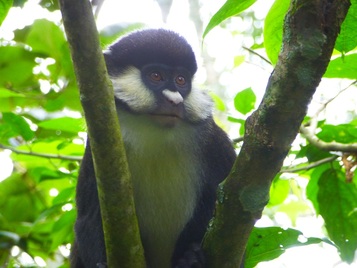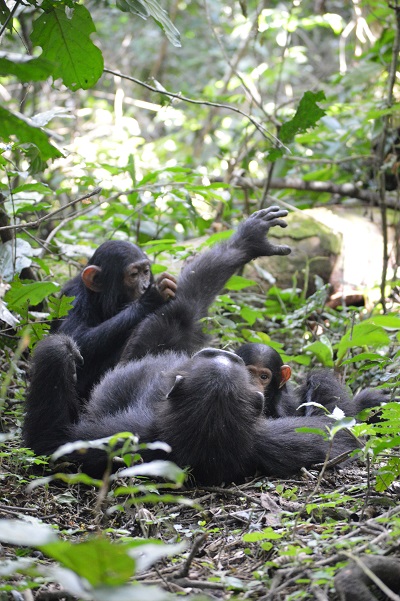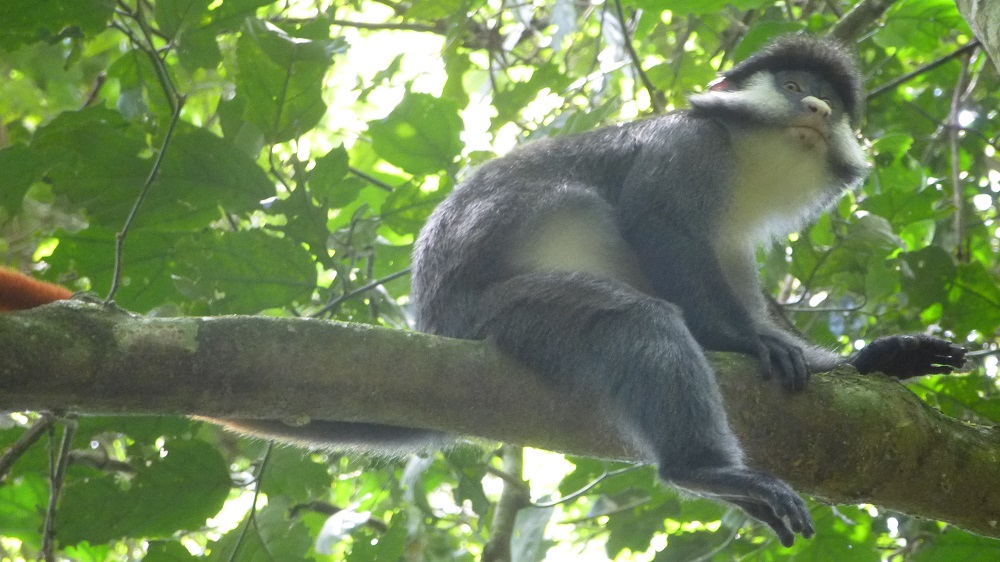 Who wouldn't want to groom this little guy?! (Image credit: Margaret Bryer) Who wouldn't want to groom this little guy?! (Image credit: Margaret Bryer) I feel like every field biologist longs for that rare moment to witness the thing that (almost) no one has ever seen before. This one may well have been mine. The moment could very well go down in my personal history as the rarest, most incredible behavior I have ever been so lucky to witness: Wallace grooming a redtail monkey. I have craved this moment, without knowing what it would be, for about a million years, you know, plus or minus. It is possible that some of you have already seen this on the KCP Facebook page (_)- I could barely stop myself from trying to post the entire FIFTEEN minutes of footage immediately after D and I witnessed it—it feels impossible to explain how rare and wonderful this interaction was. In fact I’ve been struggling with writing post (hence the delay in getting the words out with the footage) for that reason. Such a momentous occasion requires a careful touch to walk the proper line between telling the story and sharing some decent science. As many of you may already know, chimpanzees eat monkeys, albeit with varying intensity across communities. Yes, monkeys are food, not friends, for chimpanzees. Affilitative, or friendly, interactions between chimpanzees and individuals of other primate species are sufficiently rare that I have almost never read or even heard of such an encounter despite having searched for such a case on multiple occasions. The only previous report of a friendly interaction between a chimp and an individual of another species (that did not end in the demise of a monkey) that I have been able to able to track down is the personal observation of another graduate student involving the same juvenile, Wallace, engaging in a bit of play with a young baboon. Needless to say, witnessing such an encounter first hand was unexpected if not entirely unbelievable. In contrast with chimpanzees, redtails frequently interact with other primate species. Here at KNP, they often forage in mixed-species associations. I’ve read a few papers about mixed-species associations and, in fact, I often saw retails (mostly males) mixed in with the blue monkeys at Kakamega. I am by no means an expert on redtails, but luckily, my friend Maragret Bryer is! Maragret is a NYCEP graduate student studying redtail foraging and social behavior for her dissertation project (check out her website here: margaretbryer.wix.com/margaretbryer). I asked her for some a brief summary of mixed associations among redtails to help us wrap out heads around what we saw: “In a national park with 13 species of primates, interactions between species are often the most complex and surprising. Redtail monkeys spend most of their time in the company of other monkey species, specifically red colobus monkeys, black and white colobus monkeys, blue monkeys, mangabeys and occasionally L’Hoest’s monkeys. In fact, we often observe redtails being far more tolerant of other species than of other redtails from neighboring groups. In the same day, we often witness grooming and play between redtails and other monkey species, followed by chasing and aggression between redtails of different groups when ranges overlap. Protection from predators like chimpanzees and eagles and/or improved foraging may be the reasons behind all of this redtail mixed species association. Despite this seeming tolerance between species, researchers working at Kibale have also found that a hierarchy exists among frugivorous monkeys: blue monkeys and mangabeys appear to dominate the redtails in feeding competition for ripe fruits. When in the same feeding tree, blue monkeys and mangabeys gain access to higher quality sugar-rich fruits compared to redtails. The relationship between redtails and chimpanzees is more complicated. Redtails and chimps feed on many of the same fruiting tree species, but, at its simplest, the chimp-redtail interaction is that of predator-prey. Redtails tend to have a stereotypical reaction to the presence of chimps less than 50 meters away: become extremely quiet, run like hell, then sit silent and mute, not feeding or socializing for at least 45 minutes. On days when multiple chimp subgroups are around, this sequence continues on repeat for several hours. Given this typical flee-and-hide reaction by redtails to chimps, a chimp gently grooming a redtail is especially surprising.” There are a few notable features of this video worth identifying and discussing. And tons and tons of questions, most generally, is there something different about Wallace? Something sufficiently different from other chimps that he is driven to engage with non-chimps in ways that other chimps don’t? Now, before we dive into this, please do remember that this is a case-study or observations from a sample size of one encounter, thus everything that follows may indicate anomalies as easily as patterns- mostly importantly, remember, as previously indicated, the encounter itself is likely an anomaly so there may be no pattern at all! Interesting feature number 1: Did you notice how Wallace is incredibly gentle as he grooms the redtail? You can see in the close-up how gingerly he brushes his fingers through the redtail’s hair. Chimpanzees are comparatively rough with each other- both with their hands as they comb through one another’s hair and as they push and prod their partners to access new areas that need grooming. Watching it, it sometimes seems as though chimps can barely contain their excitement about grooming. Sometimes when juveniles groom younger individuals, like infant siblings, the interaction ends with the younger partners escaping to their mothers when they can’t seem to take the roughness of their big brother’s or sister’s. However, in this interaction, Wallace’s restraint and fine muscle control is notable both for his age and his species. Interesting feature number 2: Wallace’s gentle touch becomes even more remarkable as he wraps his toes around the monkey’s red tail begins to play with it. Young chimps seem to be absolutely fascinated by monkey tails. I have personally observed several juveniles and infants stealing away with monkey tails after a successful hunt and playing with it for hours (sometimes even through the night and into the next day). However, gentle, is just not a word that I would ascribe to the way the kiddies play with monkey parts. In fact, I would tend toward the opposite. I’ve seen tails flung around and tugged upon, slung around necks like a boa, thrown down and stomped on- all in the name of good fun. I thought about posting a short clip to illustrate that point, but is a bit macabre. Considering it now, I think that I’ve seen them treat sticks and stones more nicely than monkey parts. You can see just how gentle Wallace is reflected in the behavior of the redtail- which brings us to interesting feature number 2: it might not seem obvious, but this monkey is totally relaxed and comfortable. When you watch the clip, do you notice how he exposes his neck and flanks to Wallace? The redtail is expressing a behavior called “present for grooming,” which is generally regarded as one individual showing the specific areas that he or she wishes another to groom. Its very common in guenons between same-species group-mates. In other words, this redtail is using the same behavioral indicators with Wallace that he might use with another redtail. Isn’t that remarkable- to be so comfortable with something that might eat you!? Humans often have close relationships with animals that we might eat, like goats or sheep or rabbits, but take domestication away and think about it from the other side. There isn’t a human-to-nonhuman-wild-animal example that really approximates the nuances of this particular interaction, but could you ever be comfortable enough to approach and play with a juvenile polar bear? Or a lion cub? When mom is close by? Field biologists spend their whole lives trying to understand natural systems, looking for patterns and rules of intricate and complex relationships. Discovering those patterns and those rules can be surprising (or not), ground breaking, and so so satisfying. The more time I spend in the forest, the better I know the animals that live there, the more in awe I am of the variation at every node of the system. Maybe it’s the truest scientist in me that loves such small violations in established ideas so much, after all the scientific method is fundamentally about upending and rejecting hypotheses.
1 Comment
|
Kris SabbiThis blog is a forum share my personal experiences as a field researcher and traveler. Categories
All
Blog Archives
June 2022
By Category
All
|


 RSS Feed
RSS Feed
